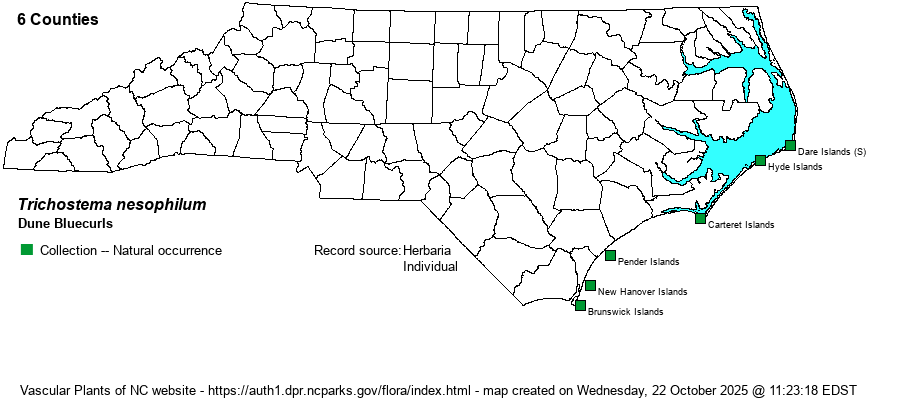| Author | K.S. McClelland & Weakley | |
| Distribution | Strictly coastal, ranging from "slightly north of Cape Hatteras, Dare County, NC south to North Island, Georgetown County, SC, north of Cape Romain" (Weakley 2018).
This recently described species is known only from coastal NC and SC. | |
| Abundance | Locally fairly common to common in several places, such as from Cape Hatteras to Bogue Banks (Carteret County), and again from southern New Hanover County through much of Brunswick County. No records yet from Onslow County. This is a State Special Concern species, with a State Rank of S2. Because of its tiny range, it is globally very rare, with a rank of G2. | |
| Habitat | This is strictly a coastal species of dunes, sand flats, and other sandy soil on barrier islands, such as in sandy openings in Maritime Scrub or edges of Maritime Forests. It does well in disturbed sandy places, with the caveat, however, that such sandy places on coastal islands are highly prized for development. |
| Phenology | Blooms from mid- or late August to frost, generally blooming about 2-3 weeks later than does the similar T. dichotomum. | |
| Identification | This is a "bushy", almost woody-looking species, with numerous stiff branches, yielding a somewhat rounded form, as opposed to a narrower and often taller form with S. dichotomum, which can also grow in sandy coastal soil. It grows to only about 1 foot tall, rarely to 1.5 feet tall, and often just as wide. It has numerous opposite leaves, but these are quite rounded, to widely elliptical, ovate, or ovoid, with a blunt tip and nearly sessile base; they average only about 1/2-3/4-inch long and slightly less wide. The other species have much narrower leaves, with T. dichotomum being elliptical and rather pointed at both ends. Lastly, this species has flowers that are pink to lavender in color, typically with a red tint than a blue tint. This species thus differs from T. dichotomum, in at least four main ways: 1) a later flowering period; 2) a bushier, more rounded growth form; 3) rounded leaves; and 4) pink to lavender flowers. Thankfully, this species is not hard to find in some areas of the state, including in some protected places such as Cape Hatteras National Seashore, Fort Macon State Park, and Fort Fisher State Recreation Area. | |
| Taxonomic Comments | This species has been known since at least the 1980s, but was not formally described until 2019, by McClelland and Weakley. It is somewhat similar to T. suffrutescens, and some botanists perhaps consider them conspecific, though Weakley (2018) and most NC biologists do consider this as a valid species.
| |
| Other Common Name(s) | Carolina Bluecurls | |
| State Rank | S2 | |
| Global Rank | G2 | |
| State Status | SC-V | |
| US Status | | |
| USACE-agcp | | |
| USACE-emp | | |

